Real Madrid C.F.
Real Madrid C.F.
From Wikipedia, the free encyclopedia
"Real Madrid" redirects here. For the basketball team, see Real Madrid Baloncesto. For the South African football club, see Real Madrid (South Africa). For other uses, seeReal Madrid (disambiguation).
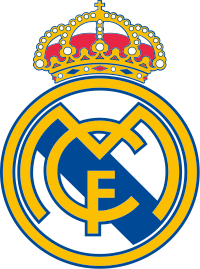 | ||||
| Full name | Real Madrid Club de Fútbol[1] | |||
|---|---|---|---|---|
| Nickname(s) | Los Blancos (The Whites)Los Merengues (The Meringues)Los Vikingos (The Vikings)[2] | |||
| Short name | RM | |||
| Founded | 6 March 1902 as Madrid Football Club[3] | |||
| Ground | Santiago Bernabéu Stadium | |||
| Capacity | 85,044[4] | |||
| President | Florentino Pérez | |||
| Head coach | Rafael Benítez[5] | |||
| League | La Liga | |||
| 2014–15 | La Liga, 2nd | |||
| Website | Club home page | |||
| Football (Men's) | Football B (Men's) | Football U-19 (Men's) |
|---|---|---|
| Basketball (Men's) | Basketball B (Men's) | |
Real Madrid Club de Fútbol (Spanish pronunciation: [reˈal maˈðɾið ˈkluβ ðe ˈfuðβol]; Royal Madrid Football Club), commonly known as Real Madrid, or simply as Real, is a professional football club based in Madrid, Spain.
Founded in 1902 as Madrid Football Club, the team has traditionally worn a white home kit since inception. The word Realis Spanish for Royal and was bestowed to the club by King Alfonso XIII in 1920 together with the royal crown in the emblem. The team has played its home matches in the 85,044-capacity Santiago Bernabéu Stadium in downtown Madrid since 1947. Unlike most European sporting entities, Real Madrid's members (socios) have owned and operated the club throughout its history.
The club is the most valuable sports team in the world, worth €2.5 billion ($3.4 billion) and the world's highest-earningfootball club for 2013–14, with an annual revenue of €549.5 million.[6][7][8] The club is one of the most widely supported teams in the world.[9] Real Madrid is one of three founding members of the Primera División that have never been relegatedfrom the top division, along with Athletic Bilbao and Barcelona. The club holds many long-standing rivalries, most notably El Clásico with Barcelona and the El Derbi madrileño with Atlético Madrid.
Real Madrid established itself as a major force in both Spanish and European football during the 1950s. The club won five consecutive European Cups, and reached the final seven times. This success was replicated in the league, where the club won five times in the space of seven years. This team, which consisted of players such as Di Stéfano, Ferenc Puskás,Gento, Raymond Kopa, and Santamaría, is considered by some in the sport to be the greatest team of all time.[10][11][12][13]
In domestic football, the club has won a record 32 La Liga titles, 19 Copa del Rey, 9 Supercopa de España, 1 Copa Eva Duarte, and 1 Copa de la Liga.[14] In international football, the club has won a record 10 European Cup/UEFA Champions League titles and a joint record 3 Intercontinental Cups, as well as 2 UEFA Cups, 2 UEFA Super Cups and a FIFA Club World Cup.
Real Madrid was recognised as the FIFA Club of the 20th Century on 23 December 2000, and named Best European Club of the 20th Century by the IFFHS on 11 May 2010. The club received the FIFA Centennial Order of Merit in 2004. The club is ranked first in the latest IFFHS Club World Ranking, setting a new ranking-points record.[15] The club also leads the current UEFA club rankings.[16]
Contents
[hide]- 1History
- 1.1Early years (1897–1945)
- 1.2Santiago Bernabéu Yeste and European success (1945–78)
- 1.3Quinta del Buitre and seventh European Cup (1980–2000)
- 1.4Los Galácticos (2000–2006)
- 1.5New president Ramón Calderón (2006–2009)
- 1.6Second Pérez term, arrival of Cristiano Ronaldo and the Mourinho era (2009–13)
- 1.7Ancelotti and La Décima (2013–2015)
- 2Crest and colours
- 3Kit manufacturers and shirt sponsors
- 4Grounds
- 5Records and statistics
- 6Support
- 7Rivalries
- 8Finances and ownership
- 9Popular culture
- 10Honours
- 11Players
- 12Personnel
- 13See also
- 14References
- 15Further reading
- 16External links
History
Main article: History of Real Madrid C.F.
Early years (1897–1945)
Real Madrid's origins go back to when football was introduced to Madrid by the academics and students of the Institución Libre de Enseñanza, which included several Cambridge and Oxford University graduates. They founded Football Club Sky in 1897, playing on Sunday mornings at Moncloa. It split into two clubs in 1900: New Foot-Ball de Madrid and Madrid Football Club.[17] On 6 March 1902, after a new Board presided by Juan Padrós had been elected, Madrid Football Club was officially founded.[3] Three years after its foundation, in 1905, Madrid FC won its first title after defeating Athletic Bilbao in the Spanish Cupfinal. The club became one of the founding sides of the Royal Spanish Football Federation on 4 January 1909, when club president Adolfo Meléndez signed the foundation agreement of the Spanish FA. After moving between grounds the team moved to the Campo de O'Donnell in 1912.[18] In 1920, the club's name was changed to Real Madrid after King Alfonso XIII granted the title of Real (Royal) to the club.[19]
In 1929, the first Spanish football league was founded. Real Madrid led the first league season until the last match, a loss to Athletic Bilbao, meant they finished runners-up to Barcelona.[20] Real Madrid won its first League title in the 1931–32 season. Real won the League again the following year, becoming the first team to have won the championship twice.[21]
On 14 April 1931, the arrival of the Second Spanish Republic caused the club to lose the title Real and went back to being named Madrid Football Club. Football continued during the Second World War, and on 13 June 1943 Madrid beat Barcelona 11–1 in the second leg of a semi-final[22] of the Copa del Generalísimo, the Copa del Rey having been renamed in honour of General Franco. It has been suggested that Barcelona players were intimidated by police,[23] including by the director of state security who "allegedly told the team that some of them were only playing because of the regime's generosity in permitting them to remain in the country."[24] The Barcelona chairman, Enric Piñeyro, was assaulted by Madrid fans.[25] However, none of these allegations have been proven and FIFA and UEFA still consider the result as legitimate. According to Spanish journalist and writer, Juan Carlos Pasamontes, Barcelona player Josep Valle denied that the Spanish security forces came before the match.[26]Instead, at the end of the first half, Barcelona coach Juan José Nogués and all of his players were angry with the hard-style of play Real Madrid was using and with the aggressiveness of the home crowd.[26] When they refused to take the field, the Superior Chief of Police of Madrid appeared, identified himself, and ordered the team to take the field.[26]
Santiago Bernabéu Yeste and European success (1945–78)
Santiago Bernabéu Yeste became president of Real Madrid in 1945.[27] Under his presidency, the club, its stadiumSantiago Bernabéu and its training facilities Ciudad Deportiva were rebuilt after the Spanish Civil War damages. Additionally, during the 1950s former Real Madrid Amateurs player Miguel Malbo founded Real Madrid's youth academy, or "cantera," known today as La Fábrica. Beginning in 1953, he embarked upon a strategy of signing world-class players from abroad, the most prominent being Alfredo Di Stéfano.[28]
In 1955, acting upon the idea proposed by the French sports journalist and editor of L'Équipe Gabriel Hanot, Bernabéu, Bedrignan and Gusztáv Sebes created an exhibition tournament of invited teams from around Europe that would eventually become what today is known as the UEFA Champions League.[29] It was under Bernabéu's guidance that Real Madrid established itself as a major force in both Spanish and European football. The club won the European Cup five times in a row between 1956 and 1960, which included the 7–3 Hampden Park final againstEintracht Frankfurt in 1960.[28] After these five consecutive successes, Real was permanently awarded the original cup and earning the right to wear the UEFA badge of honour.[30]
The club won the European Cup for a sixth time in 1966 defeating Partizan Belgrade 2–1 in the final with a team composed entirely of same nationality players, a first in the competition.[31] This team became known as the Yé-yé. The name "Ye-yé" came from the "Yeah, yeah, yeah" chorus in The Beatles' song "She Loves You" after four members of the team posed for Marca and impersonated the Beatles.[32] The Ye-yé generation was also European Cup runner-up in 1962 and 1964.[31] In the 1970s, Real Madrid won five league championships and three Spanish Cups.[33] The club played its first UEFA Cup Winners' Cup final in 1971 and lost to English side Chelsea 2–1.[34] On 2 July 1978, club president Santiago Bernabéu died while the World Cup was being played in Argentina. FIFA decreed three days of mourning to honour him during the tournament.[35] The following year, the club organized the first edition of the Trofeo Santiago Bernabéu in the memory of its former president.
Quinta del Buitre and seventh European Cup (1980–2000)
By the early 1980s, Real Madrid had lost its grasp on the Liga title until a new cohort of home-grown stars brought domestic success back to the club.[36] Spanish sport journalist Julio César Iglesias gave to this generation the name La Quinta del Buitre ("Vulture's Cohort"), which was derived from the nickname given to one of its members, Emilio Butragueño. The other four members were Manuel Sanchís, Martín Vázquez, Míchel and Miguel Pardeza; all five footballers were graduates of Real Madrid's youth academy.[36]With La Quinta del Buitre (reduced to four members when Pardeza left for Zaragoza in 1986) and notable players like goalkeeper Francisco Buyo, right-back Miguel PorlánChendo and Mexican striker Hugo Sánchez, Real Madrid had one of the best teams in Spain and Europe during the second half of the 1980s, winning two UEFA Cups, fiveSpanish championships in a row, one Spanish cup and three Spanish Super Cups.[36] In the early 1990s, La Quinta del Buitre split up after Martín Vázquez, Emilio Butragueño and Míchel left the club.
In 1996, President Lorenzo Sanz appointed Fabio Capello as coach. Although his tenure lasted only one season, Real Madrid was proclaimed league champion and players likeRoberto Carlos, Predrag Mijatović, Davor Šuker and Clarence Seedorf arrived at the club to strengthen a squad that already boasted the likes of Raúl, Fernando Hierro, Iván Zamorano, and Fernando Redondo. As a result, Real Madrid (with the addition of Fernando Morientes in 1997) finally ended its 32-year wait for its seventh European Cup: in 1998, under manager Jupp Heynckes, they defeated Juventus 1–0 in the final with a goal from Predrag Mijatović.[37]
Los Galácticos (2000–2006)
Main article: Galácticos
In July 2000, Florentino Pérez was elected club president.[38] He vowed in his campaign to erase the club's €270 million debt and modernize the club's facilities. However, the primary electoral promise that propelled Pérez to victory was the signing of Luís Figo from arch-rivals Barcelona.[39]The following year, the club had its training ground rezoned and used the money to begin assembling the famous Galácticos side that included players such as Zinedine Zidane, Ronaldo, Luís Figo, Roberto Carlos, Raúl, Fabio Cannavaro and David Beckham. It is debatable whether the gamble paid off, as despite winning the UEFA Champions League and an Intercontinental Cup in 2002, followed by La Liga in 2003, the club failed to win a major trophy for the next three seasons.[40]
The few days after the capturing of the 2003 Liga title were surrounded with controversy. The first controversial decision came when Pérez sacked winning coach Vicente del Bosque.[41] Over a dozen players left the club, including Madrid captain Fernando Hierro, while defensive midfielder Claude Makélélé refused to take part in training in protest at being one of the lowest-paid players at the club and subsequently moved to Chelsea.[42] "That's a lot [of players leaving] when the normal rule is: never change a winning team," stated Zidane.[43] Real Madrid, with newly appointed coach Carlos Queiroz, started their domestic league slowly after a hard win over Real Betis.[43]
The 2005–06 season began with the promise of several new signings: Júlio Baptista (€24 million), Robinho (€30 million) and Sergio Ramos (€27 million).[44] However, Real Madrid suffered from some poor results, including a 0–3 loss at the hands of Barcelona at the Santiago Bernabéu in November 2005.[45] Madrid's coach Wanderley Luxemburgo was sacked the following month and his replacement was Juan Ramón López Caro.[46] A brief return to form came to an abrupt halt after losing the first leg of the Copa del Rey quarterfinal, 6–1 to Real Zaragoza.[47] Shortly after, Real Madrid were eliminated from the Champions League for a fourth successive year, this time at the hands of Arsenal. On 27 February 2006, Florentino Pérez resigned.[48]
New president Ramón Calderón (2006–2009)
Ramón Calderón was elected as club president on 2 July 2006 and subsequently appointed Fabio Capello as the new coach and Predrag Mijatović as the new sporting director. Real Madrid won the Liga title in2007 for the first time in four years, but Capello was nonetheless sacked at the end of the campaign.[49]On 9 June 2007, Real played against Zaragoza at La Romareda. Zaragoza led Real 2–1 near the end of the match while Barcelona were also winning against Espanyol 2–1. A late Ruud van Nistelrooy equalizer followed by a last-minute Raúl Tamudo goal sprang Real Madrid's title hopes back into their favour.
The title was won on 17 June, where Real faced Mallorca at the Bernabéu while Barcelona and Sevilla, the other title challengers, facedGimnàstic de Tarragona and Villarreal, respectively. At half-time, Real were 0–1 down, while Barcelona had surged ahead into a 0–3 lead in Tarragona; however, three goals in the last half-hour secured Madrid a 3–1 win and their first league title since 2003.[50] The first goal came from José Antonio Reyes, who scored after a good work from Gonzalo Higuaín. An own goal followed by another goal from Reyes allowed Real to begin celebrating the title.[50] Thousands of Real Madrid fans began going to Plaza de Cibeles to celebrate the title.[50]
Second Pérez term, arrival of Cristiano Ronaldo and the Mourinho era (2009–13)
On 1 June 2009, Florentino Pérez regained Real Madrid's presidency.[51] Pérez continued with the Galácticos policy pursued in his first term, buying Kaká from Milan for a record-breaking sum of £56 million,[52] and then breaking the record again by purchasing Cristiano Ronaldo from Manchester United for £80 million.[53]
José Mourinho took over as manager in May 2010.[54][55] In April 2011, a strange occurrence happened when, for the first time ever, fourClásicos were to be played in a span of just 18 days. The first fixture was for the Liga campaign on 17 April (which ended 1–1 with penalty goals for both sides), the Copa del Rey final (which ended 1–0 to Madrid) and the controversial two-legged Champions League semifinal on 27 April and 2 May (3–1 loss on aggregate) to Barcelona.[56]
In the 2011–12 La Liga season, Real Madrid won La Liga for a record 32nd time in the leagu's history, also finishing the season with numerous club-level records set, including 100 points reached in a single season, a total of 121 goals scored, a goal difference of +89 and 16 away wins, with 32 wins overall.[57] In the same season, Cristiano Ronaldo become the fastest player to reach 100 goals scored in Spanish league history. In reaching 101 goals in 92 games, Ronaldo surpassed Real Madrid legend Ferenc Puskás, who scored 100 goals in 105 games. Ronaldo set a new club mark for individual goals scored in one year (60), and became the first player ever to score against all 19 opposition teams in a single season.[58][59]
Real Madrid began the 2012–13 season winning the Supercopa de España, defeating Barcelona on away goals, but finished as second in the league competition. A major transfer of the season was signing from Tottenham Hotspur of Luka Modrić for a fee in the region of £33 million. In the Champions League, they were drawn in the "group of death" alongside Borussia Dortmund, Manchester City and Ajax, finishing second with ten points behind Dortmund. In the round of 16, they defeated Manchester United, Galatasaray in the quarter-finals, and reached their third-straight semi-final finish in the Champions League, when they were again stopped by Dortmund. After a disappointing extra time loss to Atlético Madrid in the 2013 Copa del Rey Final (which broke a 14-year skid for Atlético), Pérez announced the departure of José Mourinho at the end of the season by "mutual agreement."[60][61] Mourinho returned to the English Premier League with Chelsea, a team he managed from 2004 to 2007.
Ancelotti and La Décima (2013–2015)
On 25 June 2013, Carlo Ancelotti succeeded Mourinho to become the manager of Real Madrid on a three-year deal.[62] A day later, he was introduced at his first press conference for Madrid where it was announced that both Zinedine Zidane and Paul Clement will be his assistants.[63]On 1 September 2013, the long-awaited transfer from Tottenham of Gareth Bale was announced. The transfer of the Welshman was reportedly the new world record signing, with the transfer price approximated at €100 million.[64] In Ancelotti's first season at the club, Real Madrid won the Copa del Rey, with Bale scoring the winner in the final against Barcelona.[65] On 24 May, Real Madrid defeated city rivals Atlético Madrid in the2014 Champions League Final, winning their first European title since 2002,[66] and becoming the first team to win ten European Cups/Champions League titles, an achievement known as "La Décima."[67]
After winning the 2014 Champions League, Real Madrid signed goalkeeper Keylor Navas, midfielder Toni Kroos and attacking midfielder James Rodríguez.[68] The club won the 2014 UEFA Super Cup against Sevilla, with two goals by Cristiano Ronaldo, the club's 79th official trophy.[69]During the last week of the 2014 summer transfer window, Real Madrid sold two players key in the previous season's successes—Xabi Alonso toBayern Munich and Ángel Di María to Manchester United, the latter for an English record fee of €75 million. This decision from the club was surrounded by controversy, however, with Ronaldo stating, "If I was in charge, maybe I would have done things differently," while Carlo Ancelotti admitted, "We must start again from zero."[70][71]
After a slow start to the 2014–15 La Liga season, which included defeats to Atlético Madrid and Real Sociedad, Real Madrid went on a record-breaking winning streak, which included wins against Barcelona and Liverpool, surpassing the previous Spanish record of 18 successive wins set by Frank Rijkaard's Barça in the 2005–06 season.[72] In December 2014, the club extended their winning streak to 22 games with a 2–0 win overSan Lorenzo in the 2014 FIFA Club World Cup Final, thus ending the calendar year with four trophies.[73] Their 22-game winning streak ended in their opening game of 2015 with a loss to Valencia, leaving the club two short of equalling the world record of 24 consecutive wins.[74] The club failed to retain the Champions League (losing 3–2 on aggregate against Juventus in the semi-finals), the Copa del Rey (4–2 aggregate loss to Atlético), and failed to land the league title (finishing two points and a place behind champions Barcelona), shortcomings that all preceded Ancelotti's sacking on 25 May 2015.[75]
Crest and colours
Emblem
The first crest had a simple design consisting of a decorative interlacing of the three initials of the club, "MCF" for Madrid Club de Fútbol, in dark blue on a white shirt. The first change in the crest occurred in 1908 when the letters adopted a more streamlined form and appeared inside a circle.[76] The next change in the configuration of the crest did not occur until the presidency of Pedro Parages in 1920. At that time, King Alfonso XIII granted the club his royal patronage which came in the form of the title "Real Madrid," meaning "Royal."[77] Thus, Alfonso's crown was added to the crest and the club styled itself Real Madrid Club de Fútbol.[76]
With the dissolution of the monarchy in 1931, all the royal symbols (the crown on the crest and the title of Real) were eliminated. The crown was replaced by the dark mulberry band of the Region of Castile.[21] In 1941, two years after the end of the Civil War, the crest's "Real Corona", or "Royal Crown", was restored while the mulberry stripe of Castilewas retained as well.[27] In addition, the whole crest was made full color, with gold being the most prominent, and the club was again called Real Madrid Club de Fútbol.[76] The most recent modification to the crest occurred in 2001 when the club wanted to better situate itself for the 21st century and further standardize its crest. One of the modifications made was changing the mulberry stripe to a more bluish shade.[76]
Home kit
Real Madrid's traditional home colours are all white, although before its foundation, in the club's first game against themselves, they adopted a blue and a red oblique stripe on the shirt to differentiate the two teams (the club crest design has a purple stripe which is not associated to this. It was incorporated the year they lost the royal crown, as it the traditional region of Castile colour); but unlike today, black socks were worn. Lastly, the black socks will be replaced by dark blue ones.[20][78] Real Madrid has maintained the white shirt for its home kit throughout the history of the club. There was, however, one season that the shirt and shorts were not both white. It was an initiative undertaken by Escobal and Quesada in 1925; the two were traveling through England when they noticed the kit worn by London-based team Corinthian F.C., one of the most famous teams at the time known for its elegance and sportsmanship. It was decided that Real Madrid would wear black shorts in an attempt to replicate the English team, but the initiative lasted just one year. After being eliminated from the cup by Barcelona with a 1–5 defeat in Madrid and a 2–0 defeat in Catalonia, President Parages decided to return to an all-white kit, claiming that the other kit brought bad luck. Years later, Leeds United switched their blue shirt for a white one after marveling at Real Madrid's 7–3 Victory against Eintracht Frankfurt in Glasgow's Hampden Park.[79] By the early 1940s, the manager changed the kit again by adding buttons to the shirt and the club's crest on the left breast, which has remained ever since. On 23 November 1947, in a game against Atlético Madrid at the Metropolitano Stadium, Real Madrid became the first Spanish team to wear numbered shirts.[27]
Real's traditional away colours are all blue or all purple. Since the advent of the replica kit market, the club has also released various other one colour designs, including red, green, orange and black. The club's kit is manufactured by Adidas, whose contract extends from 1998.[80][81] Real Madrid's first shirt sponsor, Zanussi, agreed for the 1982–83, 1983–84 and 1984–85 seasons. Following that, the club was sponsored by Parmalat and Otaysa before a long-term deal was signed with Teka in 1992.[82][83] In 2001, Real Madrid ended their contract with Teka and for one season and used the Realmadrid.com logo to promote the club's website. Then, in 2002, a deal was signed with Siemens Mobile and in 2006, the BenQ Siemens logo appeared on the club's shirt.[84] Real Madrid's shirt sponsor from 2007 until 2013 was bwin.com following the economic problems of BenQ Siemens.[85][86] It is currently Fly Emirates.
Kit manufacturers and shirt sponsors
Source:[87]
| Period | Kit manufacturer | Shirt partner |
|---|---|---|
| 1980–1982 | Adidas | — |
| 1982–1985 | Zanussi | |
| 1985–1989 | Hummel | Parmalat |
| 1989–1991 | Reny Picot | |
| 1991–1992 | Otaysa | |
| 1992–1994 | Teka | |
| 1994–1998 | Kelme | |
| 1998–2001 | Adidas | |
| 2001–2002 | Realmadrid.com * | |
| 2002–2005 | Siemens mobile | |
| 2005–2006 | Siemens | |
| 2006–2007 | BenQ-Siemens | |
| 2007–2013 | bwin | |
| 2013– | Emirates |
* Realmadrid.com appeared as shirt sponsor to promote the club's new website.
Grounds
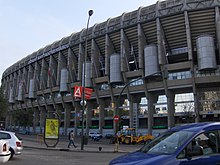 | |
| Capacity | 85,454 |
|---|---|
| Field size | 107 m × 72 m (351 ft × 236 ft)[88] |
| Construction | |
| Broke ground | 27 October 1944 |
| Opened | 14 December 1947 |
| Architect | Manuel Muñoz Monasterio, Luis Alemany Soler, Antonio Lamela |
After moving between grounds, the team moved to the Campo de O'Donnell in 1912, which remained its home ground for 11 years.[18] After this period, the club moved for one year to the Campo de Ciudad Lineal, a small ground with a capacity of 8,000 spectators. After that, Real Madrid moved its home matches to Estadio Chamartín, which was inaugurated on 17 May 1923 with a match against Newcastle United.[89] In this stadium, which hosted 22,500 spectators, Real Madrid celebrated its first Spanish league title.[20] After some successes, the 1943 elected president Santiago Bernabéu decided that the Estadio Chamartín was not big enough for the ambitions of the club, and thus a new stadium was built and was inaugurated on 14 December 1947.[27][90] This was the Santiago Bernabéu Stadium as it is known today, although it did not acquire the present name until 1955.[28] The first match at the Bernabéu was played between Real Madrid and the Portuguese club Belenenses and won by Los Blancos, 3–1, the first goal being scored by Sabino Barinaga.[27]
The capacity has changed frequently, peaking at 120,000 after a 1953 expansion.[91] Since then, there have been a number of reductions due to modernizations (the last standing places went away in 1998–99 in response to UEFA regulations which forbids standing at matches in the UEFA competition), countered to some extent by expansions.[91] The last change was an increase of about five thousand to a capacity of 85,454, effected in 2011. A plan to add a retractable roof has been announced.[90] Real Madrid has the fourth-highest of the average attendances of European football clubs, behind only Borussia Dortmund, Barcelona andManchester United.[92][93][94][95]
The Bernabéu has hosted the 1964 European Championship final, the 1982 FIFA World Cup final, the 1957, 1969 and 1980European Cup finals and the 2010 Champions League Final.[96] The stadium has its own Madrid Metro station along the 10 line called Santiago Bernabéu.[97] On 14 November 2007, the Bernabéu has been upgraded to Elite Football Stadium status by UEFA.[98]
On 9 May 2006, the Alfredo Di Stéfano Stadium was inaugurated in the City of Madrid, where Real Madrid usually trains. The inaugural match was played between Real Madrid and Stade Reims, a rematch of the 1956 European Cup final. Real Madrid won the match 6–1 with goals from Sergio Ramos, Antonio Cassano (2), Roberto Soldado (2) and José Manuel Jurado. The venue is now part of the Ciudad Real Madrid, the club's new training facilities located outside Madrid in Valdebebas. The stadium holds 5,000 people and isReal Madrid Castilla's home ground. It is named after former Real legend Alfredo Di Stéfano.[99]
Records and statistics
Main article: List of Real Madrid C.F. records and statistics
Raúl holds the record for most Real Madrid appearances, having played 741 first-team matches from 1994 to 2010. Manuel Sanchis, Jr.comes third after Iker Casillas (725), having played 711 times.[100] The record for a goalkeeper is held by Iker Casillas, with 725 appearances. With 164* caps (162 while at the club), he is also Real's most capped international player while with 127 caps (47 while at the club), Luís Figo of Portugal is Real's most capped foreign international player.[101]
Cristiano Ronaldo is Real Madrid's all-time top goalscorer, with 326 goals.[102][103] Five other players have also scored over 200 goals for Real: Alfredo Di Stéfano (1953–64), Santillana (1971–88), Ferenc Puskás(1958–66), Hugo Sánchez (1985–92) and the previous goalscoring record-holder Raúl (1994–2010). Cristiano Ronaldo holds the record for the most league goals scored in one season (46 in 2011–12). Di Stéfano's 49 goals in 58 matches was for decades the all-time highest tally in the European Cup, until it was surpassed by Raúl in 2005, which now is held by Cristiano Ronaldo with 82 goals. The fastest goal in the history of the club (15 seconds) was scored by the Brazilian Ronaldo on 3 December 2003 during a league match against Atlético Madrid.[104]
Officially, the highest home attendance figure for a Real Madrid match is 83,329, which was for a football cup competition, Copa del Rey, in 2006. The current legal capacity of the Santiago Bernabéu is 80,354.[105] The club's average attendance in 2007–08 season was 76,234, the highest in European Leagues.[106] Real has also set records in Spanish football, most notably the most domestic titles (32 as of 2012–13) and the most seasons won in a row (five, during 1960–65 and 1985–90).[1] With 121 matches (from 17 February 1957 to 7 March 1965), the club holds the record for longest unbeaten run at home in La Liga.[107]
The club also hold the record for winning the European Cup/UEFA Champions League ten times[108] and for themost semi-final appearances (26). As of September 2015, Cristiano Ronaldo is the all-time top scorer in the UEFA Champions League, with 82 goals in total, 67 while playing for Real Madrid. The team has the record number ofconsecutive participations in the European Cup (before it became the Champions League) with 15, from 1955–56 to 1969–70.[109] Among the club's on-field records is a 22-game winning streak in all competitions during the2014–2015 season, a Spanish record.[110] The same season the team tied the win-streak for games in the UEFA Champions League, with ten.[111]
In June 2009, the club broke its own record for the highest transfer fee ever paid in the history of football by agreeing to pay Manchester United€96 million (US$131.5 million, £80 million) for the services of Cristiano Ronaldo.[112][113] The fee of €76 million (over $100 million, £45.8 million) forZinedine Zidane's transfer from Juventus to Real Madrid in 2001 was the previous highest transfer fee ever paid. This record had been broken previously in June 2009, for a few days, when Real Madrid agreed to buy Kaká from Milan. The transfer of Tottenham Hotspur's Gareth Bale in 2013 was reportedly the new world record signing, with the transfer price expected at around €100 million.[64] The club's sale record came on 26 August 2014, when Manchester United signed Ángel Di María for €75 million.[114]
Support
During most home matches the majority of the seats in the stadium are occupied by season ticket holders, of which there are average of 68,670.[1] To become a season ticket holder one must first be a socio, or club member. In addition to members, the club has more than 1,800 peñas (official, club-affiliated supporters' groups) in Spain and around the world. Real Madrid has the second highest average all-time attendance in Spanish football and regularly attracts over 74,000 fans to Santiago Bernabéu; it was the second best-supported La Liga team in the 2004–05 season, with an average gate of 71,900.[115] Real Madrid is one of the best supported teams globally, and has the second largest social media following in the world among all sports teams, afterBarcelona, with over 75 million Facebook fans by October 2014.[116][117]
Real Madrid's hardcore supporters are the so-called Ultras Sur supporters, or simply Ultras. They are known for their extreme right-wing politics, akin to Barcelona's hardcore supporters group Boixos Nois. The Ultras Surs have developed an alliance with other right wing groups, most notably Lazio Irriducibili fans, and have also developed an alliance with left-wing groups. On several occasions, they have racially abused opposing players and have been investigated by UEFA for doing so.[118][119] Florentino Pérez took it upon himself to ban the Ultras from the Bernabéu and assign their seats to the general public. This decision was controversial with some of the Bernabéu faithful, however, as the lively atmosphere of games would suffer as a result.[120][121] The Ultras have since held protests outside the Bernabéu and have demanded to be reinstated and allowed to enter the grounds.[122]
Rivalries
El Clásico
Main article: El Clásico
There is often a fierce rivalry between the two strongest teams in a national league, and this is particularly the case in La Liga, where the game between Real Madrid and Barcelona is known as "The Classic" (El Clásico). From the start of national competitions, the clubs were seen as representatives of two rival regions in Spain, Catalonia and Castile, as well as of the two cities. The rivalry reflects what many regard as the political and cultural tensions felt between Catalans and the Castilians, seen by one author as a re-enactment of the Spanish Civil War.[123] Over the years, the record from Real Madrid and Barcelona is 81 victories for Madrid, 76 victories for Barcelona, and 39 draws.[124]
During the dictatorships of Primo de Rivera and especially of Francisco Franco (1939–1975), all regional cultures were suppressed. All of the languages spoken in Spanish territory, except Spanish (Castilian) itself, were officially banned.[125][126] Symbolising the Catalan people's desire for freedom, Barcelona became "More than a club" ("Més que un club") for the Catalans. According to Manuel Vázquez Montalbán, the best way for the Catalans to demonstrate their identity was by joining Barcelona. It was less risky than joining a clandestine anti-Franco movement, and allowed them to express their dissidence.[127] During Franco's regime, however, the blaugrana team was granted profit due to its good relationship with the dictator at management level, even giving two awards to him.[128]
On the other hand, Real Madrid was widely seen as the embodiment of the sovereign oppressive centralism and the fascist regime at management level and beyond– Santiago Bernabéu, the former club president for whom Real Madrid's stadium is named, fought on theNationalist side during the Spanish Civil War.[129][130] During the war, however, members of both clubs, such as Josep Sunyol and Rafael Sánchez Guerra, suffered at the hands of Francoists.
During the 1950s, the rivalry was exacerbated further when there was a controversy surrounding the transfer of Alfredo Di Stéfano, who finally played for Real Madrid and was key to their subsequent success.[131] The 1960s saw the rivalry reach the European stage when they met twice in a controversial knock-out round of the European Cup, with Madrid receiving unfavourable treatment from the referee.[132][133] In 2002, the European encounter between the clubs was dubbed the "Match of The Century" by Spanish media, and Madrid's win was watched by more than 500 million people.[134]
El Derbi madrileño
Main article: El Derbi madrileño
The club's nearest neighbour is Atlético Madrid, a rivalry being shared between fans of both football teams. Although Atlético was originally founded by three Basque students in 1903, it was joined in 1904 by dissident members of Madrid FC. Tensions escalated further after Atlético were merged with the football team of the Spanish airforce (and thus renamed Atlético Aviación), and in the 1940s, Atlético was perceived as the preferred team of Franco's regime before he revelled in Real's European success in the 1950s.[135][136]Furthermore, Real supporters initially came from the middle and upper classes while the Atlético supporters were drawn from the working class. Today, however, these distinctions are largely blurred. They met for the first time on 21 February 1929 in matchday three of the firstLeague Championship at the former Chamartín. It was the first official derby of the new tournament, and Real won 2–1.[20]
The rivalry first gained international attention in 1959 during the European Cup when the two clubs met in the semi-final. Real won the first leg 2–1 at the Bernabéu while Atlético won 1–0 at the Metropolitano. The tie went to a replay, which Real won 2–1. Atlético, however, gained some revenge when, led by former Real Madrid coach José Villalonga, it defeated its city rivals in two successive Copa del Generalísimo finals in 1960 and 1961.[137]
Between 1961 and 1989, when Real dominated La Liga, only Atlético offered it any serious challenge, winning Liga titles in 1966, 1970, 1973 and 1977. In 1965, Atlético became the first team to beat Real at the Bernabéu in eight years. Real Madrid's record against Atlético in more recent times is very favorable.[138] A high point coming in the 2002–03 season, when Real clinched the La Liga title after a 0–4 victory at Atlético at the Vicente Calderón Stadium. Atlético's first win over its city rivals since 1999 came with the Copa del Rey win in May 2013. In 2013–14, Real and Atlético were finalists of UEFA Champions League, the first final which hosted two clubs from same city. Real Madrid triumphed with 4–1 in extra time.[139] On 7 February 2015, Real suffered their first defeat in 14 years at the Vicente Calderón, a 4–0 loss.[140]
European rivalry
Real Madrid and Bayern Munich are two of the most successful clubs in the UEFA Champions League/European Cup competition, Real winning ten times and Bayern winning five times. Real Madrid versus Bayern is the match that has historically been played most often in the Champions League, with 16 matches and the European Cup with 22 matches. Real's biggest loss at home in the Champions League came at the hands of Bayern on 29 February 2000, 2–4.[141] Real Madrid supporters often refer to Bayern as the "Bestia negra" ("Black Beast"). The two teams met in the 2011–12 Champions League semi-finals, which resulted in 3–3 on aggregate, forcing extra time and penalties. Bayern won 3–1 on penalties to reach their first-ever home Champions League final. They then again met in 2013–14 UEFA Champions League semi-finals, a rematch of the 2012 semi-final, with Real Madrid winning 5–0 on aggregate.[142]
Finances and ownership
It was under Florentino Pérez's first presidency (2000–2006) that Real Madrid started its ambition of becoming the world's richest professional football club.[143] The club ceded part of its training grounds to the city of Madrid in 2001, and sold the rest to four corporations: Repsol YPF, Mutua Automovilística de Madrid, Sacyr Vallehermoso and OHL. The sale eradicated the club's debts, paving the way for it to buy the world's most expensive players, such as Zinedine Zidane, Luís Figo, Ronaldo and David Beckham. The city had previously rezoned the training grounds for development, a move which in turn increased their value, and then bought the site.[40] The European Commission started an investigation into whether the city overpaid for the property, to be considered a form of state subsidy.[144]
The sale of the training ground for office buildings cleared Real Madrid's debts of €270 million and enabled the club to embark upon an unprecedented spending spree which brought big-name players to the club. In addition, profit from the sale was spent on a state-of-the-art training complex on the city's outskirts.[145] Although Pérez's policy resulted in increased financial success from the exploitation of the club's high marketing potential around the world, especially in Asia, it came under increasing criticism for being too focused on marketing the Real Madrid brand and not enough on the performances of the team.[43]
By September 2007, Real Madrid was considered the most valuable football brand in Europe by BBDO. In 2008, it was ranked the second-most valuable club in football, with a value of €951 million (£640 million / $1.285 billion),[146] only beaten by Manchester United, which was valued at €1.333 billion (£900 million).[147] In 2010, Real Madrid had the highest turnover in football worldwide.[148] In September 2009, Real Madrid's management announced plans to open its own dedicated theme park by 2013.[149]
A study at Harvard University concluded that Real Madrid "is one of the 20 most important brand names and the only one in which its executives, the players, are well-known. We have some spectacular figures in regard to worldwide support of the club. There are an estimated 287 million people worldwide who follow Real Madrid."[150] In 2010, Forbesevaluated Real Madrid's worth to be around €992 million (US$1.323 billion), ranking them second after Manchester United, based on figures from the 2008–09 season.[151][152]According to Deloitte, Real Madrid had a recorded revenue of €401 million in the same period, ranking first.[153]
Along with Barcelona, Athletic Bilbao and Osasuna, Real Madrid is organised as a registered association. This means that Real Madrid is owned by its supporters who elect the club president. The club president cannot invest his own money into the club[154] and the club can only spend what it earns, which is mainly derived through merchandise sales, television rights and ticket sales. Unlike a limited company, it is not possible to purchase shares in the club, but only membership.[155] The members of Real Madrid, called socios, form an assembly of delegates which is the highest governing body of the club.[156] As of 2010, the club has 60,000 socios.[157] At the end of the 2009–10 season, the club board of directors of the club stated that Real Madrid had a net debt of €244.6 million, €82.1 million lower than the previous fiscal year. Real Madrid announced that it had a net debt of €170 million after the 2010–11 season. From 2007 to 2011, the club made a net profit of €190 million.[158][159]
During the 2009–10 season, Real Madrid made €150 million through ticket sales, which was the highest in top-flight football.[158] The club has the highest number of shirt sales a season, around 1.5 million.[158] For the 2010–11 season its wage bill totalled €169 million, which was second-highest in Europe behind Barcelona.[160] However, its wage bill to turnover ratio was the best in Europe at 43 percent, ahead of Manchester United and Arsenal at 46 percent and 50 percent, respectively. In 2013, Forbes listed the club as the world's most valuable sports team, worth $3.3 billion.[8]
Popular culture
Real Madrid was the featured club in the second edition of the Goal! football movie trilogy, Goal! 2: Living the Dream... (2007). The film follows former Newcastle United star Santiago Muñez as he is first scouted, and then signed by Real Madrid for the 2005–06 season. The film's creators wanted to put emphasis on the changes in Muñez's life after his move to Madrid. Production was done with the full support of UEFA, allowing the film crew to use many real life players in cameo roles. Real Madrid squad members featured in the film included Iker Casillas, Zinedine Zidane, David Beckham, Ronaldo, Roberto Carlos, Raúl, Sergio Ramos, Robinho, Thomas Gravesen, Michael Owen, Míchel Salgado,Júlio Baptista, Steve McManaman, Jonathan Woodgate and Iván Helguera. Non-Real Madrid players to make cameo appearances included Ronaldinho, Thierry Henry, Lionel Messi, Samuel Eto'o, Andrés Iniesta, Pablo Aimar, Fredrik Ljungberg, Cesc Fàbregas, Santiago Cañizares and others. In the film, both Florentino Pérez and Alfredo Di Stéfanopresented the fictional player Muñez to the club after his signing.[161]
Real, The Movie is a 2005 part feature, part documentary film that showcases the world-wide passion for Real Madrid C.F. Produced by the club and directed by Borja Manso, it follows five sub-stories of fans from around the world and their love for Real Madrid. Along with the fictional portion of the film, it also contains real footage of the squad, during training at Ciudad Real Madrid, matches, and interviews. Although the film mentions all of the squad, it mainly focuses on galácticos such as David Beckham, Zinedine Zidane, Raúl, Luís Figo, Ronaldo, Iker Casillas, and Roberto Carlos, among others. The film was originally produced in Spanish, but has been dubbed for their world-wide fanbase.
The book White Storm: 100 years of Real Madrid by Phil Ball was the first English-language history of Real Madrid. Published in 2002, it talks about the most successful moments of the club during its first centenary, having been translated into various languages. In late 2011, Real Madrid released a digital music album, entitled Legends, and a remix of the club's anthem, "Himno del Real Madrid," was released as the first single from the album.[162]
Real Madrid TV
Real Madrid TV is an encrypted digital television channel, operated by Real Madrid and specialising in the club. The channel is available in Spanish and English. It is located atCiudad Real Madrid in Valdebebas (Madrid), Real Madrid's training centre.
Honours
As of 24 May 2014, Real Madrid have won a record 32 La Liga, a record ten European Cup/UEFA Champions League and a shared record three Intercontinental Cup trophies. The club was awarded with the recognition of "FIFA Club of the 20th Century" on 23 December 2000,[163] and named "Best European Club of the 20th Century" by the IFFHS in London on 11 May 2010.[164][165] It also received the FIFA Order of Merit in 2004. Added to this, Real is allowed to wear a multiple–winner badge on their shirt during UEFA Champions League matches as they have won more than five European Cups.[30]
Domestic competitions
- Winners (32) – record: 1931–32, 1932–33, 1953–54, 1954–55, 1956–57, 1957–58, 1960–61, 1961–62, 1962–63, 1963–64, 1964–65, 1966–67, 1967–68, 1968–69, 1971–72, 1974–75, 1975–76, 1977–78, 1978–79, 1979–80, 1985–86, 1986–87, 1987–88, 1988–89, 1989–90, 1994–95, 1996–97, 2000–01, 2002–03, 2006–07, 2007–08, 2011–12
- Winners (19): 1905, 1906, 1907, 1908, 1917, 1934, 1936, 1946, 1947, 1961–62, 1969–70, 1973–74, 1974–75, 1979–80, 1981–82, 1988–89, 1992–93, 2010–11, 2013–14
- Copa Eva Duarte (the forerunner to the Supercopa de España)[168]
- Winners: 1947
- Winners: 1984–85
European competitions
- Winners (10) – record: 1955–56, 1956–57, 1957–58, 1958–59, 1959–60, 1965–66, 1997–98, 1999–2000, 2001–02, 2013–14
Worldwide competitions
- Winners: 2014
Players
Main article: List of Real Madrid C.F. players
For a list of all former and current Real Madrid C.F. players with a Wikipedia article, see Category:Real Madrid C.F. footballers.
Spanish teams are limited to three players without EU citizenship. The squad list includes only the principal nationality of each player; several non-European players on the squad have dual citizenship with an EU country. Also, players from the ACP countries—countries in Africa, the Caribbean, and the Pacific that are signatories to the Cotonou Agreement—are not counted against non-EU quotas due to the Kolpak ruling.
Current squad
- As of 26 August 2015[175]
Note: Flags indicate national team as defined under FIFA eligibility rules. Players may hold more than one non-FIFA nationality.
|
|
Out on loan
Note: Flags indicate national team as defined under FIFA eligibility rules. Players may hold more than one non-FIFA nationality.
|
|
Personnel
Current technical staff
See also: List of Real Madrid C.F. managers
| Position | Staff |
|---|---|
| Head coach | Rafael Benítez |
| Assistant coach | Antonio Gómez |
| Assistant coach | Fabio Pecchia |
| Goalkeeping coach | Xavi Valero |
| Fitness coach | Paco de Miguel |
| Match delegate | Chendo |
- Last updated: 10 June 2015
- Source: Real Madrid
Management
See also: List of Real Madrid C.F. presidents
| Position | Staff |
|---|---|
| President | Florentino Pérez |
| 1st Vice-president | Fernando Fernández Tapias |
| 2nd Vice-president | Eduardo Fernández de Blas |
| Secretary of the Board | Enrique Sánchez González |
| Director General | José Ángel Sánchez |
| Director of the President's Office | Manuel Redondo |
| Director of the Social Area | José Luis Sánchez |
- Last updated: 7 July 2014
- Source: Board of Directors, Organisation

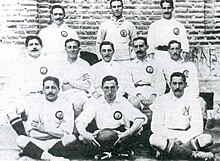

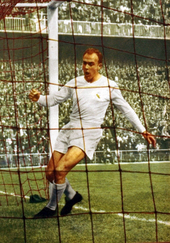
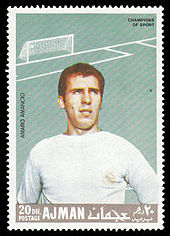


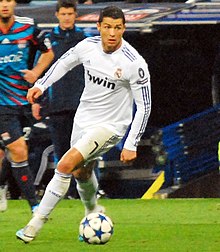





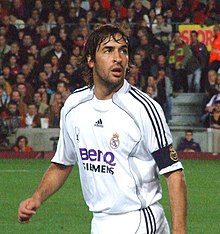

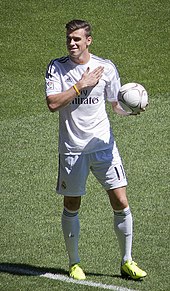


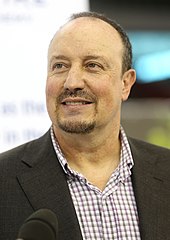

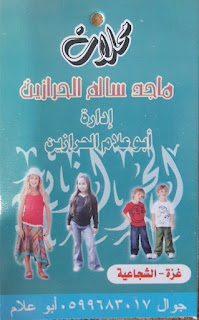
تعليقات
إرسال تعليق